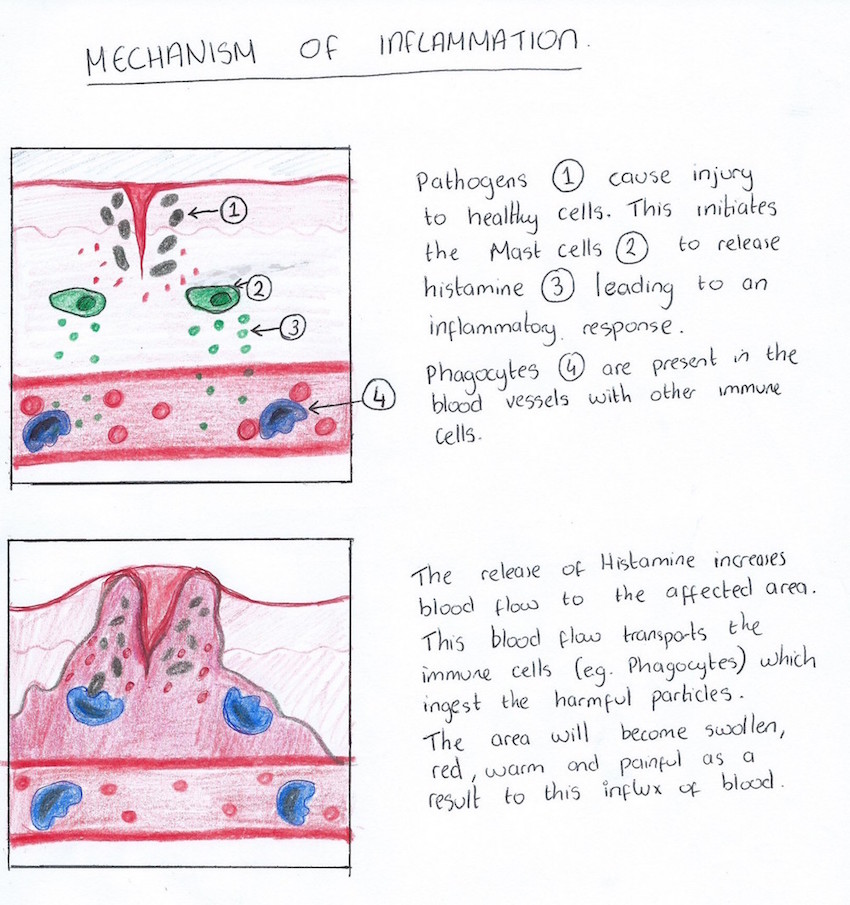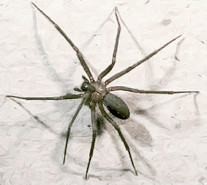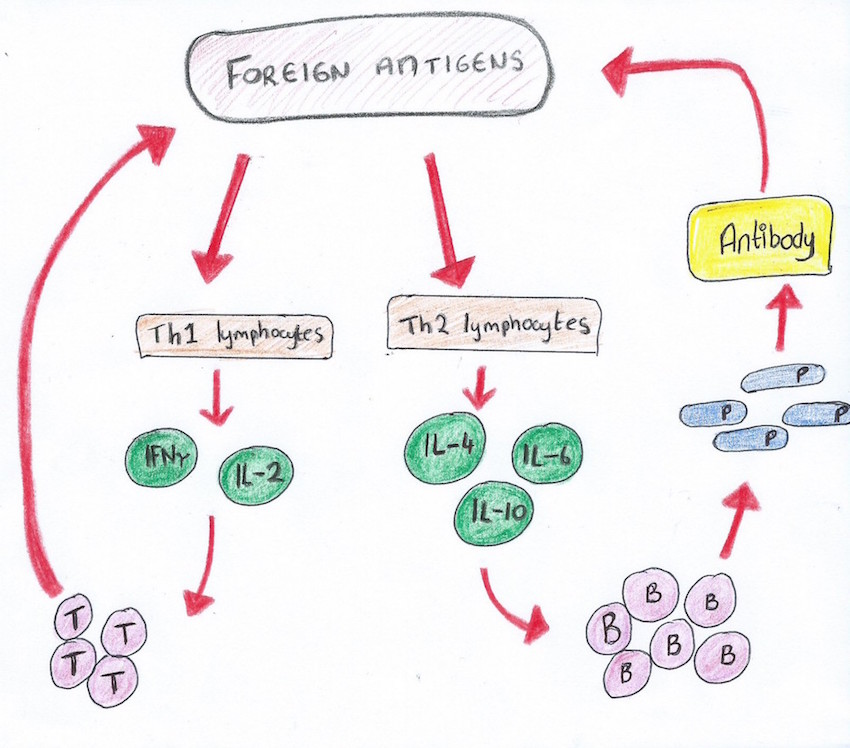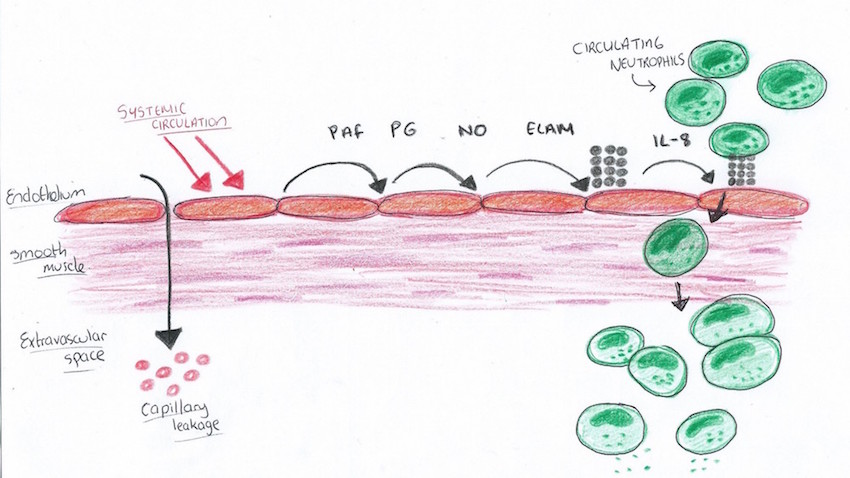|
Size: 16659
Comment:
|
← Revision 37 as of 2016-05-06 20:29:36 ⇥
Size: 16657
Comment:
|
| Deletions are marked like this. | Additions are marked like this. |
| Line 93: | Line 93: |
| * Bennett, M. (2010): Neuropathic Pain, Second edition. Oxford, Oxford University Press. 4-5 | * Bennett, M. (2010): Neuropathic Pain, Second edition. Oxford, Oxford University Press: 4-5 |
| Line 95: | Line 95: |
| * Clin, A.; (1988): Proteins Of The Inflammatory Reaction. 183-190 | * Clin, A.; (1988): Proteins Of The Inflammatory Reaction: 183-190 |
| Line 99: | Line 99: |
| * Linley, JE; Rose, K; Ooi, L; Gamper, N; (2010): Understanding Inflammatory Pain: Ion Channels Contributing To Acute And Chronic Nociception 459(5):657-69. | * Linley, JE; Rose, K; Ooi, L; Gamper, N; (2010): Understanding Inflammatory Pain: Ion Channels Contributing To Acute And Chronic Nociception 459(5): 657-69. |
| Line 101: | Line 101: |
| * Payne, K. S.; Schilli, K.; Meier, K.; Rader, R. K.; Dyer, J. A.; Mold, J. W.; Stoecker, W. V. (2014). Extreme pain from brown recluse spider bites: Model for cytokine-Driven pain. JAMA Dermatology: 150(11), 1205-1208. | * Payne, K. S.; Schilli, K.; Meier, K.; Rader, R. K.; Dyer, J. A.; Mold, J. W.; Stoecker, W. V. (2014). Extreme pain from brown recluse spider bites: Model for cytokine-Driven pain. JAMA Dermatology 150(11): 1205-1208. |
| Line 103: | Line 103: |
| * Sommer, C.; Kress, M.; (2004): Recent Findings On How Pro-Inflammatory Cytokines Cause Pain: Peripheral Mechanisms In Inflammatory And Neuropathic Hyperalgesia: 361(1-3):184-7. | * Sommer, C.; Kress, M.; (2004): Recent Findings On How Pro-Inflammatory Cytokines Cause Pain: Peripheral Mechanisms In Inflammatory And Neuropathic Hyperalgesia 361(1-3): 184-7. |
| Line 105: | Line 105: |
| * Schneider, J.;(2001): Zytokine Bei Neuropathischen Schmerzen: 50(6):416-226. | * Schneider, J.;(2001): Zytokine Bei Neuropathischen Schmerzen 50(6): 416-226. |
| Line 107: | Line 107: |
| * Szolcsányi, J.;(2015): Effect Of Capsaicin On Thermoregulation An :Update With New Aspects, Temperature: 2:2. 277-296. | * Szolcsányi, J.;(2015): Effect Of Capsaicin On Thermoregulation An :Update With New Aspects, Temperature 2:2: 277-296. |
| Line 111: | Line 111: |
| * Zhang, J.; An, J.; (2009): Cytokines, Inflammation and Pain: 45(2): 27-37. | * Zhang, J.; An, J.; (2009): Cytokines, Inflammation and Pain 45(2): 27-37. |
Mechanism of the Inflammatory and Neuropathic pain (Hyperalgesia) - The Role of the Pro-Inflammatory Cytokines
When researching both inflammatory pain and neuropathic pain, it can be stated that they both differ but also are analogous. They contrast as inflammatory pain is the damage of the bodies’ tissues whereas neuropathic pain is the damage of the somatosensory system of the body, the Peripheral Nervous System (PNS) and Central Nervous System (CNS). Both however are strongly related with regards to cytokines. Pro-inflammatory cytokine production is stimulated, either induced or increased with the onset of either of these chronic pains.
Contents
Inflammatory Pain
Inflammation is a vital, defensive immune response in the nervous system to many pathological pain states. Pathogens, xenobiotics and mechanical damage (injury) are examples of stimuli which are harmful to the body and will therefore induce an inflammatory response . The aim of this complex mechanism is to retain homeostatic balance. Inflammatory pain is a non-neuropathic pain, which is therefore known as nociceptive. In other words, this type of pain is caused by damage to the tissue.
Inflammatory responses can be either beneficial or harmful to the body depending on the types of cells involved and how badly the tissue is damaged. The initiation, maintenance and resolution of the inflammation greatly impact the effect the inflammation has on the organism. Inflammatory responses have been vital throughout evolution as an important mechanism of survival and self-defence.
Inflammatory responses lead to pain due to the excitation of nociceptive pathways. Inflammation and damage to tissues stimulate the nociceptors. Inflammation is an endogenous stress meaning that it originates from within the organism instead of being an external factor. Nociceptors are specialized sensory neurons. These peripheral neurons have an important role in the detection of stimuli, in the skin, joints, and a variety of other organs, that may cause harm. For example, they detect both extreme pressure and temperature in order to avoid tissue damage. Chemicals that may result in injury are also detected. These harmful stimuli are picked up by the nociceptors are brought to the brain by electrical signals. The sensation of these neurons picking up the stimuli is pain and it differs in intensity depending on both the strength of the stimuli and also the area of the body where the nociceptors are located. Capsaicin is an example of a stimuli which activates the cutanous warmth receptor and polymodal nociceptors which then causes long-term functional and structural damage of neural elements. It induces heat loss as a defense mechanism and also will lead to the organism avoiding external warmth. (Szolcsanyi, 2015)
Increased excitability of the nociceptors alters the ion channel activity, such as TPRV1, in the affected fibers. This then leads to molecular change in the nerves involved.
Phases of Inflammatory Responses
The first stage is known as the acute phase. These initial reactions occur just seconds to minutes after the injury to the tissue occurs. During this phase, there is a change in the plasma concentration of a type of proteins called Acute Phase Proteins (APP). If there is an increase in concentration of these proteins they are positive APP while a decrease in the concentration means that they are negative APP. The response of APP differs in different species. Different types APP genes are regulated by specific cytokines. Pro-inflammatory cytokines are secreted which cause a series of molecular changes in endothelial cells, fibroblasts and neutrophils. Examples of these cytokines are IL-8 and TNF-α. Macrophages, mast cells and lymphocytes are important immune cells in the secretion of cytokines. (Kizil et al, 2015)
Blood flow will increase around the affected area leading to an external red appearance. The transport of macrophages to the damaged area will activate the complement system. This is illustrated in Figure 1, "Inflammatory Process". Edema will occur during the acute phase due to the discharging of the excess blood plasma, which contain immunoglobulins or fibrins, to the site of inflammation. This is what causes the tissue to swell. T and B cells of the lymphatic system recognize the antigens and release the swelling of the tissue.

Fig 1.
Inflammatory Process (As provided by Wikimedia Commons)
This acute stage of inflammation could become chronic if the response is not fast enough. This chronic stage causes significantly more damage to the tissue. To avoid the occurrence of chronic inflammation and serious tissue damage, the quick regulation of the homeostasis is important. Inflammatory mediators and both the innate and adaptive immune systems coordinate acute and chronic inflammations that underlie many diseases of the organism. (Kizil et al, 2015 )
Neuropathic Pain
Neuropathic pain is defined as the disturbance of action or pathological change in a nerve. The definition for neuropathic pain has been changed over recent years by the International Association for the Study of Pain (IASP). In 1994 it was ‘pain initiated or caused by a primary lesion or dysfunction of the nervous system’. Now it is viewed by IASP as ‘pain arising as a direct consequence of a lesion or disease affecting the somatosensory system’. This therefore insinuates that dysfunction without proof of injury is no longer regarded as meeting the standard for neuropathic pain. Neuropathic pain due to nerve injury is a prevalent condition of which syndromes include diabetic, cancer, ischemic neuropathies, and phantom limb pain. It arises when damaged or neighbouring undamaged axons are sensitised such that they induce nociceptive signaling in the central nervous system. (Bennet, 2010)
Mechanism
Neuropathic pain is portrayed as an aberrant activation of pain pathways and can occur as a result of injury. The injury may be to peripheral nerves and posterior roots (peripheral neuropathic pain) and spinal cord and brain (central neuropathic pain).
Cytokines role in regards to pain and hyperalgesia and link with inflammatory pain: There is ample evidence from experimental studies (such as the brown recluse spider) that pro-inflammatory cytokines cause or amplify neuropathic as well as inflammatory pain. Afferent nerve fibers are directly acted on by cytokines and further mediators such as prostaglandins and nerve growth factors. Pro-inflammatory cytokines can be inhibited. Inhibition of pro-inflammatory cytokines, either by synthesis inhibitors, inhibitors of cleavage from the cell membrane, by direct antagonists, or by anti-inflammatory antibodies, reduces pain and hyperalgesia in most cases studied. Cytokine inhibition may be regarded as treatment for neuropathic pain.(Schneider, 2001)
Experimental Investigation
Bites from the brown recluse spider (as depicted below in Figure 2) can cause extreme pain. Cytokine release causes this discomfort.

Fig 2.
Brown Recluse Spider (As provided by Wikimedia commons)
Observations
BRS bites were recorded clinically. The mean pain level in these cases 24 hours after the spider bite was severe: 6.74 (2.75) on a scale of 0 to 10. Narcotics may be needed to provide relief in some cases. The difference in pain level by anatomic region was not significant. Escalation observed in 22 of 23 cases, increasing from low/none to extreme within 24 hours, is consistent with a cytokine pain pattern, in which pain increases with the increase of inflammatory cytokines.
Conclusions and Relevance
These findings in BRS bites support the theory of cytokine release in inflammatory pain. A larger experiment is needed to confirm the findings reported. The extreme pain from many BRS bites stimulates better prevention and treatment techniques.
(Payne et al, 2014)
Cytokines
Cytokines are small regulatory, non-structural proteins produced by white blood cells. Their molecular weight ranges between 8-40,000 Daltons, and their structure is quite diverse. Some of them form long-chain 4-helix bundles, e.g. interleukin (IL)-6, others jelly rolls, e.g. tumor necrosis factor-a (TNF-a ), and others beta-trefoils, e.g. IL-1b.
Cytokines can be divided into; lymphokines (cytokines made by lymphocytes), monokines (cytokines made by monocytes), chemokines (cytokines with chemotactic activities), and interleukin (cytokines made by one leukocyte and acting on other leukocytes). (Zhang and An, 2009) There is no amino acid sequence motif or 3D structure that links cytokines; rather it’s their biological activities that allow us to group them into different classes. Cytokines are primarily involved in host responses to disease or infection. Their actions depend on the hormonal concentrations, and are transmitted through high affinity receptors having binding constants ranging between 10-12 and 10-10 M. Sometimes only a few receptors need to be activated per cell to elicit a response. They are produced on demand and travel only over short distances. (Sommer and Kress, 2004)
Cytokines may act on the cells that secrete them (autocrine action), on nearby cells (paracrine action), or on distant cells (endocrine action). It is common for different cell types to secrete the same cytokine or for a single cytokine to act on several different cell types (pleiotropy). Cytokines are redundant in their activity, meaning similar functions can be stimulated by different cytokines. In addition to that they are often produced in a cascade, in other words one cytokine stimulates its target cells to create additional cytokines.
Pro-inflammatory Cytokines and Pain
Introduction of anti-inflammatory cytokines or the blockage of pro-inflammatory cytokines reduces hyperalgesia. (Zhang and An, 2009)
Pain is associated with inflammation; nerve endings sense the swelling of local tissues, which guarantees inflammation. Inflammatory pain is characterized by an increased sensitivity to mechanical or heat stimuli of the affected tissue. Following tissue injury, an inflammatory response is generated by local macrophages and this is further amplified by migrating blood cells. The various inflammatory mediators as well as the tissue acidification act synergistically to induce and maintain the development of pain and hyperalgesia. (Sommer and Kress, 2004)

(Watkins and Maier)
Foreign antigens stimulate immune mechanisms which are either cell-mediated (Th1) or antibody mediated (Th2). Both Th1 and Th2 lymphocytes produce cytokines (IL-2, IL-4 etc.). Th1 cytokines stimulate the growth of T-lymphocytes which are cytotoxic while Th2 cytokines stimulates B-lymphocyte production. These B-lymphocytes results in the plasma cell production of antibodies. (Watkins and Maier)
The primarily used cytokines are the interleukins (IL), which indicate a product of a leukocyte and a target leukocyte cell. There are 18 known cytokines of that kind (IL-1 till IL-18). They play a major role in inflammation, therefore an important role in relation to pain. Some cytokines promote inflammation and are called pro-inflammatory cytokines, whereas others suppress the activity of pro-inflammatory cytokines and are called anti-inflammatory. Each type works along different kinds of cells. So IL-4 and IL-10 are potent activators of B-lymphocytes, which are responsible for antibody formation to a foreign antigen.
Cytokines that “help” promote B cells antibody formation are classified as T lymphocyte helper cell of the type 2 class (Th2); their counterpart are the cytokines that help the type 1 class (Th1). Th1 cytokines help in the process of cellular immunity where T lymphocytes attack and kill virus-infected cells.
IL-1β
Interleukin-1beta is a pro-inflammatory cytokine that is produced and secreted under pathological conditions e.g. during neuropathies, tumor growth or in chronic inflammatory diseases like rheumatoid arthritis. They arise from many cell types, like mononuclear cells, fibroblasts, Schwann cells and endothelial cells. Their presence has been detected in the dorsal root ganglion neurons, which suggests possible autocrine or paracrine action on sensory processing. IL-1 also plays a central role in the generation of mechanical hyperalgesia. An experiment to prevent inflammatory hyperalgesia was performed on mice by the administration of IL-1 receptor antagonist and neutralizing antibodies to IL-1 receptors to reduce pain associated behavior. IL-1β was found to also increase the production of substance P and prostaglandin E2 (PGE2) in a number of neuronal and glial cells. (Sommer and Kress, 2004)
TNF-α
Tumor Nicrosis Factor - α, also known as cachectin, is another inflammatory cytokine that plays a key role in inflammatory and neuropathic hyperalgesia. TNF acts on several different signaling pathways through two cell surface receptors, TNFR1 and TNFR2 to regulate apoptotic pathways. TNF-α receptors are present in both neurons and glia. Intraplantar injection of complete Freund's adjuvant in adult rats resulted in significant elevation in the levels of TNF-α, IL-1β, and nerve growth factor (NGF) in the inflamed paw. A single injection of anti-TNF-α antiserum before the Complete Freund's Adjuvant (CFA) significantly delayed the onset of the resultant inflammatory hyperalgesia and reduced IL-1β but not NGF levels. TNF binding protein (TNF-BP), an inhibitor of TNF, is a soluble form of a transmembrane TNF-receptor. When TNF-BP is administered systemically, the hyperalgesia normally observed is completely eliminated. (Zhang and An, 2009)
Figure 2 illustrates the pro-inflammatory effects of both IL-1β and TNF-α.

(Watkins and Maier)
The endothelial cells are stimulated by TNF and IL-1 cytokines which activate the cascade of mediators. These mediators are pro-inflammatory and decrease the strength of the smooth muscle walls of the vessels. Capillary leakages of the area increases due to the cytokines. The mediator cascade include platelet activating factor (PAF), prostaglandin (PG), nitric oxide (NO) and endothelial leukocyte adhesion molecule (ELAM). ELAM has a role in the adhesion of neutrophils to the endothelium. The neutrophils move into the tissues where they are then degranulated, these processes are carried out with the help of chemokines such as interleukin-8. This is important in the prevention of further tissue damage by the neutrophils.
Conclusion
Both inflammatory and neuropathic pain are vitally important in the defense mechanism of the organism, whether induced by direct damage to nerve fibers or to body tissue. As outlined above, these two forms of chronic pain are what induces the production of cytokines. The rapidly expanding knowledge of this strong connection between these protein mediators and both inflammatory and neuropathic pain allows the further development in medical fields such as immunity, inflammation and disease.
Citations
- Bennett, M. (2010): Neuropathic Pain, Second edition. Oxford, Oxford University Press: 4-5
- Clin, A.; (1988): Proteins Of The Inflammatory Reaction: 183-190
- Kizil, C.; Kyritsis, N.; Brand, M. (2015): Effects Of Inflammation On Stem Cells. EMBO reports 16(4): 416-420.
- Linley, JE; Rose, K; Ooi, L; Gamper, N; (2010): Understanding Inflammatory Pain: Ion Channels Contributing To Acute And Chronic Nociception 459(5): 657-69.
- Payne, K. S.; Schilli, K.; Meier, K.; Rader, R. K.; Dyer, J. A.; Mold, J. W.; Stoecker, W. V. (2014). Extreme pain from brown recluse spider bites: Model for cytokine-Driven pain. JAMA Dermatology 150(11): 1205-1208.
- Sommer, C.; Kress, M.; (2004): Recent Findings On How Pro-Inflammatory Cytokines Cause Pain: Peripheral Mechanisms In Inflammatory And Neuropathic Hyperalgesia 361(1-3): 184-7.
- Schneider, J.;(2001): Zytokine Bei Neuropathischen Schmerzen 50(6): 416-226.
- Szolcsányi, J.;(2015): Effect Of Capsaicin On Thermoregulation An :Update With New Aspects, Temperature 2:2: 277-296.
- Watkins, L.R; Maier, S.F; (1999): Cytokins And Pain: 1-5, 159-161.
- Zhang, J.; An, J.; (2009): Cytokines, Inflammation and Pain 45(2): 27-37.
